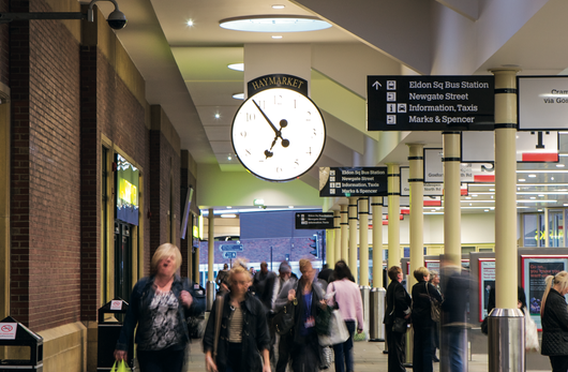10 lighting design thoughts for proximity zones at transport hubs
Brightening travellers’ moods
Whether at airports, train stations or bus terminals, transport interchanges bring people into close contact with one another. Narrow transition points, so-called zones of proximity, trigger feelings of discomfort, tension and stress in some travellers that can pose health, safety and security risks.
Smart lighting concepts can help to alleviate anxiety. Using technologies aimed at opening spaces up, sharpening visual acuity and enhancing overall spatial awareness, they offer effective ways to brighten travellers’ moods.
10 lighting design thoughts for proximity zones at transport hubs
1. The space between us
How people perceive personal space is influenced by a variety of factors, including cultural upbringing, gender, age and personality. Most of us cherish our personal space and are very sensitive about infringements by others. In his seminal work The Hidden Dimension, the cultural anthropologist Edward T. Hall defined four “zones of proximity” that he found to be relatively consistent across all cultures:
• Intimate distance: embracing, touching > 0 – 46 cm
• Personal distance: interactions with family members & close friends > 46 – 122 cm
• Social distance: interactions with acquaintances > 1.2 – 3.7 m
• Public distance: e.g. at public speaking engagements > 3.7 – 7.6 m or more
Based on this theory, it is clear that travellers frequently encounter situations in which their personal space is violated, albeit usually only for brief moments. While most people accept the closeness to others at proximity zones as unavoidable, it can be assumed that many are not completely at ease. Well-conceived lighting solutions can offer relief.
2. Differentiation and layering
Given the complexity of transport environments, lighting designers combine natural, accent, ambient, background and other forms of illuminance to create differentiated, multi-layered schemes that lend a natural visual hierarchy to architectural elements. At high-traffic zones with close proximity, layering helps to enhance peoples’ perception skills and ability to process visual information. This gives travellers added reassurance, enabling them to proceed quickly and safely with confidence.
3. Improved recognition
Travellers walking or standing at transport hubs tend to pay more attention to vertical surfaces in their visual field than to horizontal ones, a factor that must be taken into account in designing the lighting. Properly illuminating the walls with indirect and accent lighting enhances object and people recognition. Travellers generally feel more comfortable when they can clearly see who is approaching them. Good vertical illuminance and uniformity are also essential for CCTV visualisation and facial recognition.
4. Opening spaces up
Whether at high-density transition points or other areas of transport environments, a bright ceiling can positively influence our mood and behaviour. For one, it lends visual height to a room or corridor, elevating a space and opening it up. Ceiling illumination softens shadows, thereby making a space appear less oppressive. A bright ceiling directs our vision upward. We feel uplifted in our spirits. It subconsciously enhances the travel experience.
5. Facilitating wayfinding
Measures designed to provide assistance with orientation and finding one’s way around transportation hubs also help to minimise stress levels. Accent lighting solutions that highlight directional signage, display panels and maps do just that, provided that they are conspicuous and easily recognisable.
6. The psychology of colour
Although reactions to colours are somewhat subjective, they do have an influence on our emotions and behaviour. Warm colours such as red, orange and yellow generally tend to evoke feelings of warmth and comfort, whereas cool colours such as blue, purple and green are more likely to elicit feelings of calmness and relaxation. Accordingly, lighting solutions with a cool colour temperature are usually a more suitable choice for transport areas with high pedestrian traffic.
7. Nothing beats natural
The positive psychological effects of natural daylight are manifold and well-documented. Sunshine brightens up our day, even when the sun is not shining. Daylight directly influences our well-being and sense of satisfaction. What’s more, it’s free, environmentally friendly and saves energy. Intelligent lighting schemes integrate natural daylight into the overall concept at various points throughout transport environments, including crowded areas. However, care must be taken to minimise glare, a frequent side effect of direct sunlight entering a building through windows and skylights.
8. Emergency ready
Safety concerns are always present in the minds of travellers. Emergency lighting can help to allay fears at proximity zones as well as other transport areas. As in the case of the Voyager family of luminaires from Thorn, it is important that these solutions are manufactured and tested in accordance with the latest safety and electromagnetic compatibility standards. In Europe, requirements for emergency lighting systems are specified by EN 60598-1, EN 60598-2-22, EN 62471, EN 55015 and ISO7010.
9. A ray of hope
Zones of proximity can evoke a fear of tight spaces or claustrophobia in some people. In fact, claustrophobia is one of the most common phobias of all. For travellers suffering from claustrophobia, brightness at the exits of densely populated corridors can quite literally be the proverbial light at the end of a tunnel – in other words, a ray of hope.
10. A source of inspiration
At their best, transportation lighting designs do much more than help travellers to better manage tension, stress and discomfort levels – at high-density zones of proximity and throughout the facility. They serve as a source of inspiration, sparking our interest for architectural details and aesthetic design elements, directing our attention to points of interest, and elevating our appreciation for the entire complex. In short: They brighten our travel mood.

